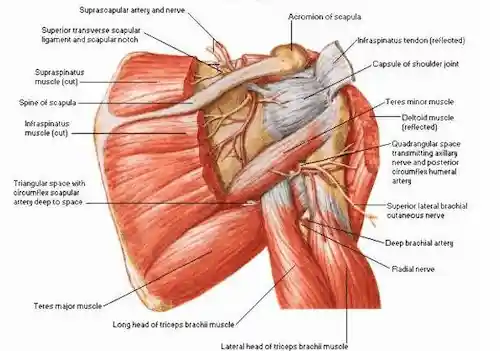Table of Contents
Teres Major Origin and Insertion
The Teres major is a broad and cord-like muscle that originates from an oval area on the dorsal surface of the inferior angle of the scapula and passes upwards and laterally to end as a flat tendon that is inserted into the medial lip of the intertubercular groove(sulcus) of anterior surface of the humerus. The flat tendon of latissimus dorsi winds around its lower border and comes to lie in front of the upper part of the muscle at its insertion. Teres major is part of the Scapulohumeral muscles, that is, the intrinsic muscles of the shoulder, the others being the supraspinatus, infraspinatus, teres minor, subscapularias (SITS muscles or Rotator cuff muscles) and then the deltoid muscle.
Teres Major Nerve Supply
Teres Major is innervated by the lower subscapular nerve (from the C5 and C6 cervical segments of the spinal cord, the C6 being the main segmental innervation.) that enters the muscle through its anterior surface. This nerve also innervates subscapularis and lies in the angle between the subscapular and circumflex scapular arteries.
Blood Supply of Teres Major Muscle
The blood supply of Teres major is from the subscapular artery which is a branch of the axillary artery; the muscle is also supplied by the circumflex scapular arteries which is a part of the scapular anastomoses.
Teres Major Action and Function
When Teres major acts alone, it functions as an adductor and medial rotator of the humerus and helps to extend the flexed arm. Teres major also assists the other short muscles in steadying the upper end of the humerus as the deltoid muscle pulls up the bone into abduction at the shoulder joint.
Tests for Teres Major
The test for Teres major is carried out when the arm is first abducted arm and then adducted against resistance; the teres major muscle is seen and felt behind the posterior axillary fold above the upper border of latissimus dorsi.
Clinical application of Teres major tendon
The Teres major tendon can be transplanted posteriorly to provide lateral rotation when the infraspinatus and Teres minor are paralyzed.
